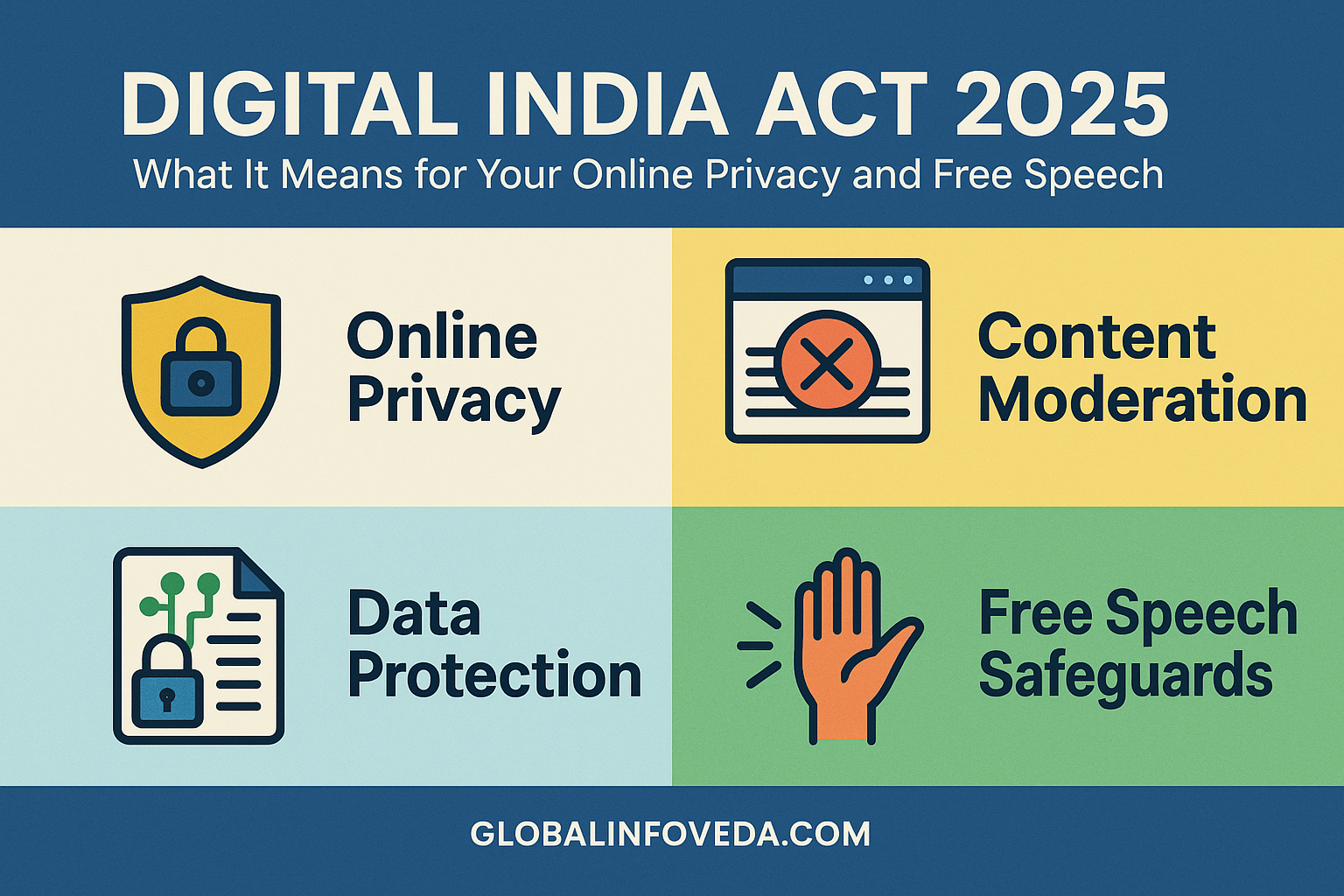📜 Digital India Act 2025
In 2025, India is on the cusp of a digital governance revolution with the introduction of the long-awaited Digital India Act (DIA). Positioned as the successor to the now-outdated Information Technology Act, 2000, the DIA promises to redefine how India’s rapidly growing digital population—over 900 million users—interacts with the internet, platforms, and the state.
The act is designed not just as a legal upgrade, but as a forward-looking, principles-based digital constitution, aligning India with international standards of privacy, algorithmic transparency, child safety, and ethical AI governance while safeguarding sovereignty and cultural context.
🏛️ What Is the Digital India Act?
Drafted by the Ministry of Electronics and Information Technology (MeitY), the DIA aims to:
- Modernize internet law for the AI-driven platform economy
- Create enforceable user rights and compliance duties
- Establish institutional oversight through independent boards
- Introduce tech-neutral principles for emerging risks (quantum, metaverse, neurotech)
It replaces the Information Technology Act, 2000, and synergizes with:
- Digital Personal Data Protection Act (DPDPA), 2023
- Cybersecurity Framework for Critical Infrastructure
- Global benchmarks like GDPR, the US Algorithmic Justice Act, and UNESCO AI Ethics Recommendation
🔐 Privacy & Data Protection: Expanded Safeguards
1. Granular User Consent Architecture:
- Layered disclosures for high-risk processing
- Real-time consent dashboards
- Legal basis for withdrawal of consent enforced within 48 hours
2. Data Fiduciaries Must:
- Publish quarterly data use transparency reports
- Provide user-friendly privacy notices in 12+ Indian languages
- Enable “data neutrality” – no differential access to services based on data opt-outs
3. Government & Public Access:
- State surveillance governed by court-approved proportionality warrants
- “Sunset clause” audits for any emergency surveillance order
- Whistleblower immunity if state violates user privacy unlawfully
🗣️ Speech, Moderation & Platform Fairness
1. Algorithmic Due Process:
- Every user action (ban, boost, block) requires a log of cause + appeal method
- Digital platforms required to enable offline mode submissions for rural users
2. Intermediary Grading System:
- Platforms labeled as Basic, Significant, or Systemic Risk Intermediaries
- Higher-level entities must:
- Submit to algorithmic audits
- Appoint India-based grievance nodal officers
3. Bias Detection & Rights Protection:
- Mandatory AI audits for bias against caste, gender, religion, language
- NLP filters must comply with linguistic pluralism safeguards
🧠 AI, Synthetic Media & Emerging Tech Controls
1. AI Disclosure Labels (Digital Watermarks):
- Applies to text, image, voice clones, avatars
- Political, financial, and health-related content must include prominent machine-origin disclosures
2. Deepfake Redress Protocol:
- Verified complaints resolved within 6 hours if risk is imminent (e.g., reputation or violence)
- Platforms must maintain synthetic content risk registries accessible to regulators
3. Kids & Teens Online:
- Zero-targeting for ads under age 13
- Age verification via multi-factor parental consent
- Teen tech usage reports optional for parents (opt-in only)
📊 Impact on Business, Creators & Advertisers
1. Creators & Content Ecosystem:
- Takedown appeals required to include human review + escalation path
- Verified creators protected against bulk copyright fraud through creator indemnity registry
2. MSMEs & Startup Innovations:
- Compliance sandbox for under-50,000 user platforms for 2 years
- Zero-fee data portability integration with UPI-like public APIs
3. Political & Government Ads:
- Must include real-time expenditure disclosures
- AI-generated content banned in political campaign materials without human co-signature
📅 Institutional Roadmap Ahead
- DIA to be introduced in Monsoon Session 2025, followed by:
- Phase I: Data Rights Rules
- Phase II: AI Moderation Standards
- Phase III: Grievance Redressal Expansion
- Establishment of the National Digital Trust Authority (NDTA)
- Pilot testing in 5 languages + tribal-digital interface frameworks (North-East & Adivasi regions)
🧾 Final Word
The Digital India Act 2025 represents more than policy—it reflects a paradigm shift in tech-era governance. If executed with transparency, equity, and interoperability at its core, it will position India as a global model for user-first digital democracy.
It empowers Indians not just as consumers or voters—but as “digital nagriks” with dignity, voice, and sovereignty over their data, identity, and online expression.
📢 Stay informed about tech policy, digital rights, and governance innovation at GlobalInfoVeda.com
